Trail
& Fell running equipment |
|
|
|
|
|
|

|
|
        -
Quick links to the equipment advice pages... -
Quick links to the equipment advice pages...
 |
 |
 |
 |
 |
 |
 |
 |
|
|
|
|
|
|
|
|
|
|
|
|
|
|

We
stock a wide and growing range of trail running equipment
in our Windermere Lake District store, click
here.
 |
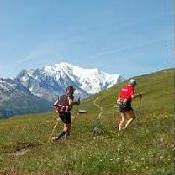 |
 |
General
equipment lists for trail & fell running
When anyone books a
running course with Icicle, they are
sent a detailed course specific kit list,
though as a free resource you can view a generic
trail running kit list clicking on the logo
to the right. This page |
 |
|
is
designed to go into greater detail on the different
types of mountain running kit that are on the market,
but our focus is to give you good generic advice,
rather than to promote specific brands or models
of kit. At its core, trail / fell running is about moving
fast and light in the mountains, with a minimalist
approach. It is not about huge kit lists - essentially
any pair of trainers, shorts and a t-shirt will
do. If you don't believe it, read 'Born to Run'
by Chris McDougall, about the Tuarahumara. |
 |
 |
 |
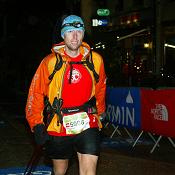 |
 |
Safety
equipment
Never forget that when running
in the mountains, the weather can turn in a matter
of minutes, and you need to have enough kit with
you to stay safe. Waterproof jacket and sometimes
trousers too should be carried. If the weather is
likely to be good, then just a lightweight jacket
is fine, but for bad weather a full weight Goretex
style jacket is often required. Carry a small first
aid kit to cope with any blisters, and also some
strapping tape. The tape is great for supporting
turned ankles, bad blisters, and rubbing from shoes
or straps. Also carry an emergency survival blanket
(foil type) in case of extreme cold or injury, as
well as your mobile phone with the emergency services
numbers pre-programmed into the memory. |
 |
 |
 |
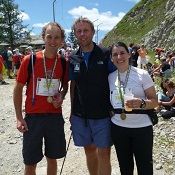 |
 |
Base
layers
Your base layer clothing should
be comfortable and light, to allow your skin to
breathe, but to protect it from rubbing and the
sun. Their are many good materials to choose from,
but the selection really comes down to personal
preference. Some like wearing shorts, whilst others
prefer tights. Your experience will guide you in
this choice, but we recommend you stick to what
you normally choose to run it, be it around the
local park, or over the mountains. Don't select
any base layer that is too thick, as you want it
to wick the sweat and heat away from your body,
not to hold a clammy layer against you. One bit
of advice, is that you dress in black like a ninja,
you will cook when it's hot. Light is right. |
 |
 |
 |
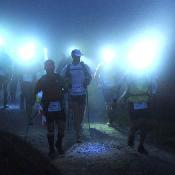 |
|
Night
equipment
The only extra equipment you
need for running at night is a decent head torch.
The market is full of good LED style head torches
(e.g. Petzl Nao), with elasticated head bands to
keep them securely on your head. Often they have
lense adaptors so you can select a narrow or diffused
light beam, to cater for different terrain and visibility.
On many races that have night time during the event,
runners often are asked to carry a spare head torch
and batteries. This can seem over the top at first,
but to be stuck in the mountains without a torch
in the night, is dangerous. For your safety many
items of clothing, and equipment, have bits of light
reflective material on them, so you can easily be
spotted. |
 |
 |
 |
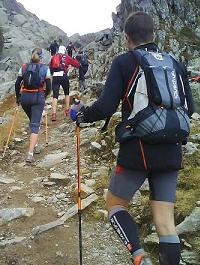 |
 |
Running
rucksacks
In the shops you will find
running rucksacks from 2 litres up to 20 litres,
with all sorts of options for extra pockets, different
strap systems, etc. These cater for any need from
a short training run, up to a multi-day ultra marathon.
For day runs, a good size would be around 8-10 litres,
and for an ultra-trail 12 litre packs such as the
Salomon S-Lab ADV Skin 12 litre pack are ideal.
Look for straps to attach your poles too, if they
don't fit inside, and also fittings for your prefered
type of hydration system. Try any rucksack on that
you wish to purchase to check the fit, and try the
waist / chest strap(s) system to see if it suits
your body shape. Try the pack with a reaslistic
load in it, not empty. |
 |
 |
 |
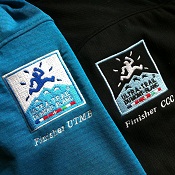 |
 |
Insulation
layers
A topic often neglected by
trail runners! Everyone remembers getting hot and
a bit sweaty when running, but in the mountains
you can get cold too. It's well worth carrying a
thin gilet jacket or long sleeved top, to add as
an extra layer if it gets windy or the temperature
drops. On many long trail races this is obligatory
kit that can be verified at a control during the
race. Gloves and a warm hat are also very useful.
A thin pair of fleece gloves is generally enough,
and for a hat many people prefer to take a Buff
type hat that can also double as a neck warmer,
sweat band, or even a balaclava. Some runners carry
just a cap as insulation for the head, but in the
Alps, it is better to keep warm. |
 |
 |
 |
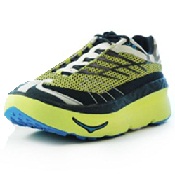 |
 |
Trail
running shoes
There is a bewildering choice
of trail shoes on the market, from minimalist shoes
such as the Vibram 5 fingers, to the maximum cushioning
shoes like Hokas. A good medium is provided by shoes
including the Salomon XT Wings, Brookes Cascada,
and TNF Singletrack. Don't fixate on too much technology.
Select a shoe that fits you well, and is perhaps
up to one full size bigger that you would normally
use, to allow for your feet swelling and for a longer
toe box to protect their feet in descent. Also look
for a reasonable grip on the base, and a lacing
system that allows for easy adjustment when out
running. Everyone has their own preferences, so
if you have a shoe that works for you, stick with
it. |
 |
 |
 |
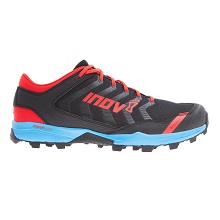 |
 |
Fell
running shoes
When you are mountain running in the Lake District, cushioning is provided by the soft mountain ground, and it's far more important to have a shoe with a low profile to keep you close to the mountain, and with excellent grip. Even on the dry days, the ground is often still wet underfoot in the fells, and so traction is the key priority. Don't worry about getting waterproof shoes, as once the water comes over the top of them, they trap the water in. A durable upper that lets the water out again is ideal. Brands to consider include the Inov8 range such as the X-Talon or Mudclaw, or the Salomon Fellraiser and Speedcross models. Buying good footwear for fell running, is the best investment you'll make for safety and enjoyment! |
 |
 |
 |
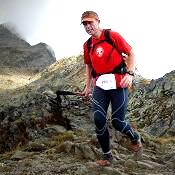 |
 |
Compression
kit
You don't need to become a
lycra clad trail warrior, but there are proven benefits
from using compression technology in and / or after
running for recovery. You can select from anything
from compression socks, to tights, tops and arm
covers too. The benefits of using this kit are that
they help reduce lactic build up in muscles, but
at the pace you normally run in the mountains, this
generally isn't an issue. They do assist with recovery
after a hard training session or race, and are gaining
popularity in Europe and around the world. The best
advice is not to think that this kit will magic
wonderous results, but can be used to help look
after you during a run and afterwards. If you recover
well anyway, save your money. |
 |
 |
 |
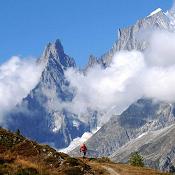 |
|
Sun
protection
The higher you run, the less
protection from the sun you get, so the use of sun
screen / block and protective clothing becomes more
important. Just to work against you, sweating will
remove the sun cream, so it's a hard act to get
right. Most trail runners opt for clothing and cream,
to help protect them. A sun cap or visor with head
band works great at keeping your face in the shade,
but also you need to think about wearing light coloured
clothing, and remembering to top up on the sun cream
whenever you feel your skin burning. It is very
hard to go out running for the day in the mountains
in the sun, without getting a little sun tan, but
just ensure that it is only a tan, never a burn. |
 |
 |
 |
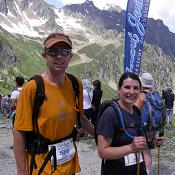 |
 |
Running
poles
Some races insist on carrying
poles, whilst others ban them, so at present it
seems like the trail running community is still
split. It is clear that the elite racers generally
do not use poles, but on most races over 85% of
participants carry them. There are a wide range
of trail specific products on the market, but the
lighter they are, the easier they will break. Lightweight
normal walking poles are fine to use, and you can
remove the snow baskets to make them easier to use.
Using poles can take a quarter of the load off your
legs on an ascent, and up to a third on a long descent,
which is why they are so popular. If you haven't
run with poles, give it a try, but don't use the
wrist loops in case you fall. |
 |
 |
 |
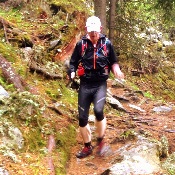 |
 |
Trail
nutrition
Everyone has their own favourite
running fuel, be it energy gels or cheese and pickle
sandwiches! Most experience runners adapt what they
eat for different stages of a long run, so they
eat proteins and fats in the first thirds of a race
(e.g. meats and cheeses), then complex carbohydrates
(e.g. pasta, potatoes, bread) in the middle third,
then simple carbs (e.g. sugars in sweets, gels)
in the final section. You will find that your tastes
change as you run for longer, and you must listen
to your body, as it is amazing for generating cravings
for what it needs. On long Alpine trail races, a
salty vermicelli soup is one of the runners favourites,
as it replenishes the electrolytes, hydrates, and
provides complex carbohydrates. |
 |
 |
 |
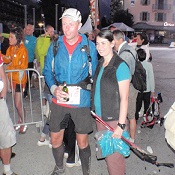 |
 |
Hydration
systems
It's the battle of water bottle
vs bladder system (e.g. Platypus or Camelback).
It is hard to deny the ease of availability of water
on the bladder system, but there are two issues
to consider; firstly is the difficulty most runners
have with judging how much they have drunk so often
they run out and are surprised, and secondly the
ease of damaging the system with a puncture or leak
thus losing the water. A bottle is harder to use,
but is easier to guage usage on, and there's less
to go wrong. A mix of the two systems isn't a bad
plan at all. On longer runs, electrolyte powders
are useful, to replenish minerals lost through sweating.
Do note that it is as important to not over hydrate,
as it is not to get de-hydrated. |
|
 |
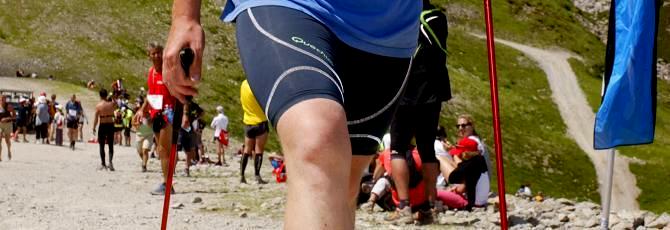 |
|
|
|
 |
| Our
range of running trips |
 |
 |
|
|
|
 |

|
 |
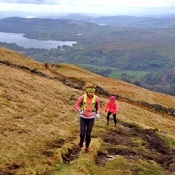
Intro Trail &
Fell Running |
|
 |
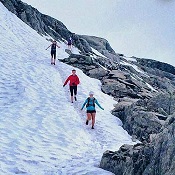
|
|
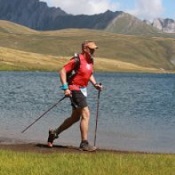
|
 |

|
|
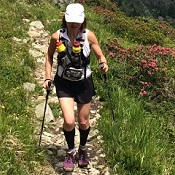
| 1st
time Ultra runners course |
|
 |
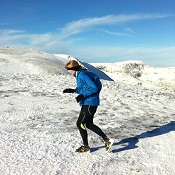
|
|

Lake
District
night runner |
|
|
 |
|
| Free
resources |
 |
 |


 |
FREE
Podcast
Getting into trail running...
Trail
running is a fastgrowing sport, and
this podcast explains what it involves,
how to get into it, and also goes through
all of the equipment that is required. |
|
|
|
|
 |


 |
FREE
Resource - Fell &
Trail running kit list...
If you are planning on attending one
of our trail running courses, you can
see a kit check list of the clothing
and equipment that we recommend you
take. |
|
|
|
|
 |
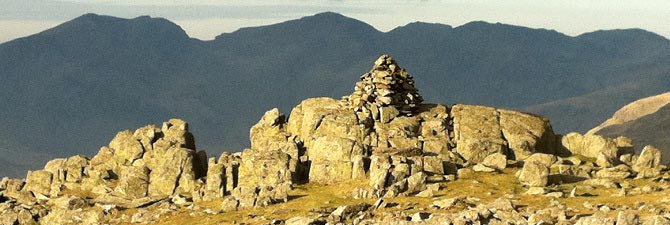 |
 |
| Suggested
reading and kit |
 |
 |
|
 |
| Why
choose our trips? |
 |
 |
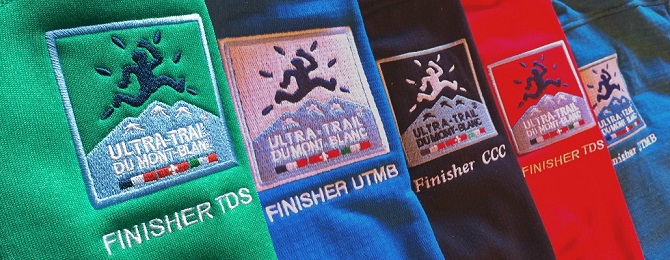 |
 |
 |
The
photo above sums it up. All of these finisher jackets
of the UTMB race series belong to our head running
leader. We genuinely think that there is no other
operator out there who is more credible! |
 |
There
are several other operators who also offer trail
running camps, and we aren't afraid to advertise
that fact. Please look at their itineraries to see
how they differ from ours. |
 |
We
don't offer talks from 'celebrity' runners, or go
in for the chardonnay in a hot tub 'lifestyle',
or quasi-scientific courses. Ours are run by people
who do it, not talk the talk. |
 |
The
effect on our prices is that we can offer you great
value. We genuinely believe that you'll spend more
time actually running and in the mountains on our
courses, than with anyone else. |
 |
Anyone
who is leading you will be a finisher of one of
the iconic trail races, such as the Ultra Trail
du Mont Blanc, Tor des Geants, Leadville or WS100. |
|
|



